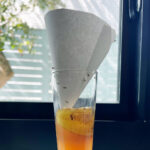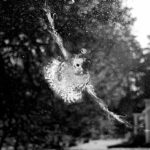Fruit flies, those tiny insects often buzzing around our fruit bowls, engage in surprisingly complex mating rituals. Scientists have been studying these rituals to understand the fundamental mechanisms of decision-making and motivation in the brain. Recently, researchers at Harvard Medical School delved into the intricate process of how male fruit flies decide when and how to court a female. Their findings, published in Neuron, reveal a fascinating interplay of internal drives, external cues, and even a touch of chance in the fly’s mating behavior. This discovery not only sheds light on insect behavior but also offers potential insights into human conditions like addiction and depression, where motivation circuits in the brain may go awry.
The Fruit Fly Courtship Ritual: A Detailed Look
Before a male fruit fly even considers mating, he engages in a series of actions that can be likened to a miniature, insect version of courtship. The process often begins when a male encounters a female, frequently in environments like specialized mating chambers used for scientific observation. The initial interaction typically involves the male fly tapping the female with his leg. This isn’t just a random touch; his legs are equipped with pheromone-sensing receptors, allowing him to gather crucial information about the female’s species and sexual maturity.
Following this initial assessment, if the male is interested, he may pursue the female, often quite persistently. A key element of fruit fly courtship is the “wing song.” To serenade the female, the male extends one wing and vibrates it rapidly. This vibration produces a species-specific song, a crucial auditory signal in fly communication and mate recognition. This elaborate courtship ritual, however, isn’t automatic. Before launching into this performance, the male fly makes a critical decision: is this female worth his efforts?
The Decision to Mate: Motivation, Perception, and Chance
The Harvard Medical School study highlights that the male fly’s decision to initiate courtship is not solely based on instinct. It’s a nuanced process influenced by a combination of factors: his internal state (primarily his level of sexual motivation or “libido”), external stimuli (his perception of the female’s “quality”), and an intriguing element of chance.
Researchers found that a small cluster of about 20 neurons in the male fly’s brain, known as P1 neurons, acts as the courtship command center. When a male fly taps a female, a flurry of signals, both excitatory (“Go ahead!”) and inhibitory (“Don’t bother!”), flood into this P1 center. These signals are the result of processing both internal and external information.
A key internal factor is dopamine, a neurotransmitter known to play a crucial role in motivation and reward in both insects and humans. Males who have been deprived of mating opportunities have higher dopamine levels. This increased dopamine acts as a powerful motivator, making them more likely to initiate courtship.
External stimuli also play a vital role. If the male perceives the female as “low quality”—perhaps she has already mated, is not sexually mature, or her pheromones signal low receptivity—the P1 center receives more inhibitory signals. Conversely, a sexually mature, unmated female sends more excitatory signals.
Dopamine’s Pivotal Role in Courtship
Dopamine’s influence extends beyond just the initial decision to court. The study revealed that dopamine levels also affect the male’s persistence in courtship. When dopamine levels are high, the P1 neurons become less sensitive to inhibitory signals. This can lead a male to pursue a female even under less-than-ideal circumstances. Conversely, males with low dopamine levels might initiate courtship half-heartedly but are more likely to give up quickly if the female is not immediately receptive.
“Dopamine tells the command center how to respond initially and when to give up,” explains Dragana Rogulja, one of the study’s lead authors. “The decision to court is a function of these neurons.”
The Element of Chance: It’s Not Always Deterministic
Interestingly, even highly motivated males paired with seemingly ideal females don’t initiate courtship every single time they tap. The researchers observed that even in optimal conditions, courtship initiation occurred only about 44 percent of the time. Similarly, males with lower motivation or less ideal targets still courted occasionally. This suggests that the decision to court involves an element of chance, much like a weighted coin toss.
This element of chance is a key differentiator between motivational circuits in the brain and circuits responsible for sensory or motor functions. While we need certainty when crossing a street or coordinating movements, decisions related to motivation, like pursuing a mate, may benefit from some degree of randomness. This randomness might introduce flexibility and adaptability into behavior, preventing rigid, reflexive responses.
Implications for Understanding Human Motivation Disorders
Understanding the neurobiological mechanisms behind fruit fly mating decisions has broader implications. The researchers believe that insights gained from studying these simple circuits in fruit flies can provide valuable clues to understanding more complex motivational disorders in humans, such as addiction and depression.
In addiction, individuals are driven to pursue harmful substances or behaviors despite negative consequences. In depression, a lack of motivation can paralyze individuals, making it difficult to engage in even basic daily activities. Crickmore, another lead author, suggests that these conditions might represent disruptions in the probability distribution of motivational behaviors, pushing individuals too frequently towards destructive actions or too rarely towards productive ones.
The researchers emphasize that historically, discoveries in fruit fly research have often translated to significant advances in understanding human biology. The study of how flies mate, therefore, offers a powerful model for unraveling the intricacies of motivation and decision-making, with potential benefits for addressing human health challenges.
Conclusion: More Than Just Instinct
The mating rituals of fruit flies, far from being simple instinctive behaviors, are governed by a complex interplay of neurobiological factors. The decision of how flies mate is influenced by internal motivation driven by dopamine, external sensory information about potential mates, and an inherent element of chance. This research provides a fascinating glimpse into the fundamental mechanisms of decision-making in the brain and opens avenues for understanding and potentially treating human disorders related to motivation. Further research into the genes and circuit principles underlying this element of chance in fruit fly motivation promises to deepen our understanding of both insect and human behavior.

